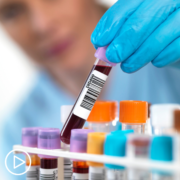Patient Considerations That Impact MPN Treatment Decisions
Patient Considerations That Impact MPN Treatment Decisions from Patient Empowerment Network on Vimeo.
How can personal choices play a role in your MPN care? Dr. John Mascarenhas reviews factors that should be considered, including lifestyle and overall health, when choosing therapy for essential thrombocythemia (ET), polycythemia vera (PV), or myelofibrosis (MF).
Dr. John Mascarenhas is Associate Professor of Medicine at the Icahn School of Medicine at Mount Sinai (ISMMS) and the Director of the Adult Leukemia Program and Leader of Clinical Investigation within the Myeloproliferative Disorders Program at Mount Sinai. Learn more about Dr. Mascarenhas, here.
Related Programs

|

Why You Should Speak Up About MPN Symptoms and Treatment Side Effects |

|
Transcript
Katherine Banwell:
Outside of testing, what other factors should be considered when choosing treatment?
Dr. Mascarenhas:
I think patient expectation. So, sometimes physicians and family will impose what they want for a patient, and that may not be what the patient really wants. So, I have learned over the years that it’s crucial to make sure that you understand the patient and what the patient’s expectations, desires, and that’s influenced by the life they’ve lead or the remaining life that they want to live and their own personal religious and spiritual beliefs.
So, I think knowing your patient and understanding what their expectations are, it’s fundamental, and sometimes, it’s overlooked. So, understanding that, I think, is very crucial. And then, dividing what are the objectives of the treatment in a given patient? Is it really to improve anemia in some patient versus perhaps a different patient, it may be to improve their quality of life and reduce their symptom burden. And then in other patients, it may be purely trying to cure the disease with therapies that may be aggressive, which may not be appropriate for an older patient where toxicity could outweigh any potential benefit of survival or longevity. So, you really have to have a discussion with the patient or caregivers, and then define what are the goals in that individual to personalize that approach for that patient.
Katherine Banwell:
Right. Right. And, there’s the patient’s overall health, comorbidities, other things like that?
Dr. Mascarenhas:
Yeah, because we are not treating a disease in isolation usually. So, patients come with baggage posed of past diseases, current diseases.
And sometimes patients are not “fit” for certain types of therapies because they may be sick or they may have organ dysfunction that would make certain types of treatment approaches ill-advised because the toxicity could be higher. So, absolutely, you need to know their comorbid index, how much comorbidities they have and also their performance status, how active and how well they are in general.
Katherine Banwell:
Are there specific biomarkers that may affect prognosis or treatment?
Dr. Mascarenhas:
So, yes and no. I mean, I think that’s an area of intense interest and research. So, we have identified certain biomarkers that have, as I mentioned, prognostic significance, and that may influence treatment decisions. So, patients who have, for example, as we discussed next-generation sequencing and we see their mutations that are present, if they have an accumulation of high molecular risk mutations, that may give us a sense that perhaps that patient may not enjoy the full benefit and duration of benefit of, for example, a JAK inhibitor as another patient that has a less complex disease.
And, that doesn’t necessarily mean that the therapy is not appropriate for the patient. But it may help us plan and be prepared to move on to the next therapy sooner or to be more vigilant for changes that would tell us it’s time to move on. So, I think they help us maybe get a general sense of things and put things into perspective. They don’t always necessarily inform us on a change in therapy immediately or the next or the most immediate therapy. But I do think that that will change because I would predict in the next five to 10 years, I think that the number of available drugs for myelofibrosis, for example, will likely double from what it is now. I think we will have an armamentarium to choose from, and what we will learn from trials that are ongoing is there may be certain profiles, mutations, chromosomal profiles, other clinical variable profiles that we will learn from these trials that will help us to find upfront, “Well, this profile really should go with his medication. That profile should go with that medication.”
An early of example that would be we’re learning that not all patients with the JAK2 mutation are created equal, that you can have different burdens of JAK2 mutation.
And, patients with low burden JAK2 mutation, for example, may fare better with up a specific JAK to inhibitor like pacritinib than patients who get treated with other JAK inhibitors like ruxolitinib.
So, there are differences even within patient defined by mutation that may help us predict which of the JAK inhibitors, as an example, may be more appropriate as a first-line therapy. So, I think that will evolve more so over the next five to 10 years.














